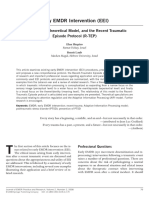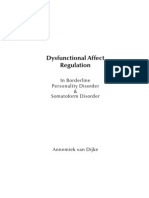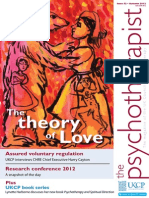Flashback Management
Flashback Management
Uploaded by
xyhmCopyright:
Available Formats
Flashback Management
Flashback Management
Uploaded by
xyhmOriginal Description:
Copyright
Available Formats
Share this document
Did you find this document useful?
Is this content inappropriate?
Copyright:
Available Formats
Flashback Management
Flashback Management
Uploaded by
xyhmCopyright:
Available Formats
FLASHBACK MANAGEMENT IN THE TREATMENT OF COMPLEX PTSD
By Pete Walker , 925 283-4575
A significant percentage of adults who suffered ongoing abuse or neglect in childhood suffer from Complex Post Traumatic Stress Disorder. One of the most difficult features of this type of PTSD is extreme susceptibility to painful emotional flashbacks. Emotional flashbacks are sudden and often prolonged regressions [amygdala hijackings] to the frightening circumstances of childhood. They are typically experienced as intense and confusing episodes of fear and/or despair - or as sorrowful and/or enraged reactions to this fear and despair. Emotional flashbacks are especially painful because the inner critic typically overlays them with toxic shame, inhibiting the individual from seeking comfort and support, isolating him in an overwhelming and humiliating sense of defectiveness. Because most emotional flashbacks do not have a visual or memory component to them, the triggered individual rarely realizes that she is re-experiencing a traumatic time from childhood. Psychoeducation is therefore a fundamental first step in the process of helping clients understand and manage their flashbacks. Most of my clients experience noticeable relief when I explain PTSD to them. The diagnosis seems to reverberate deeply with their intuitive understanding of their suffering. When they understand that their sense of overwhelm initially arose as an instinctual response to truly traumatic circumstances, they begin to shed the awful belief that they are crazy, hopelessly oversensitive, and/or incurably defective. Flashbacks strand clients in the feelings of danger, helplessness and hopelessness of their original abandonment, when there was no safe parental figure to go to for comfort and support. Hence, Complex PTSD is now accurately being identified by many as an attachment disorder. Flashback management therefore needs to be taught in the context of a safe relationship. Clients need to feel safe enough with the therapist to describe their humiliating experiences of a flashback, so that the therapist can help them respond more constructively to their overwhelm in the moment. Without help in the moment, the client typically remains lost in the flashback and has no recourse but to once again fruitlessly reenact his own particular array of primitive, self-injuring defenses to what feel like unmanageable feelings. I find that most clients can be guided to see the harmfulness of these previously necessary, but now outmoded, defenses as misfirings of their fight, flight, freeze, or fawn responses. These misfirings then, cause dysfunctional warding off of feelings in four different ways: [1] fighting or over-asserting ones self with others in narcissistic and entitled ways such as misusing power or promoting excessive self-interest; [2] fleeing obsessive-compulsively into activities such as workaholism, sex and love addiction, or substance abuse [uppers]; [3] freezing in numbing, dissociative ways such as sleeping excessively, over-fantasizing, or tuning out with TV or medications [downers]; [4] fawning in self-abandoning and obsequious codependent relating. [The fawn response to trauma is delineated in my earlier article on Codependency and Trauma in The East Bay Therapist, Jan/Feb 03]. As clients learn that their originally helpful defenses now needlessly hinder them, they can begin to replace them with the anxiolytic and therapeutic responses to flashbacks that are outlined and listed at the end of this article. I introduce this phase of the work by giving the client a copy of this list of cognitive, affective, somatic and behavioral techniques to use as a toolbox outside of the session. These tools are also elaborated ongoingly in our sessions. I continually notice that the clients who acquire the most recovery are those who carry the list with them or post it up conspicuously at home until they are thoroughly conversant with it. As clients begin to derive benefit from responding more functionally to being triggered, there are more opportunities to work with their active flashbacks in session. In fact, it often seems that their unconscious desire for mastery schedules their flashbacks to occur just prior to or during sessions. In helping them to achieve some mastery, my most ubiquitous intervention is helping them to deconstruct the outmoded alarmist tendencies of the inner critic. This is essential, as Donald Kalshed explicates throughout The Inner World of Trauma, because the inner critic grows rampantly in traumatized children and because the
inner critic is the primary initiator of most flashbacks. The psychodynamics of this is that continuous abuse and neglect force the childs inner critic [superego] to overdevelop hypervigilance and perfectionism hypervigilance to recognize and defend against danger, and perfectionism to try to win approval and safe attachment. Unfortunately, safety and attachment are rarely or never experienced. Hypervigilance progressively devolves into intense performance anxiety and perfectionism festers into a virulent inner voice that increasingly manifests self-hate, self-disgust and self-abandonment at every imperfection. Eventually the child grows up, but she is so dominated by feelings of danger, shame and abandonment, that she is unaware that adulthood now offers many new resources for achieving internal and external safety. She is stuck seeing the present as rife with danger as the past. I sometimes think of this phase of the work as rescuing the client from the hegemony of the critic. Despite the negative connotation rescuing has in many circles, I believe there is an unmet childhood need for rescue that I help meet when I save my client from the critic like mom didnt save her from abusive dad, or like the neighborhood didnt rescue her from her alcoholic family. This rescue process then, is a gradual emancipation from self-alienation, and a gradual deliverance from the internalized parents who trigger the client with flashback-inducing catastrophizations and perfectionistic invectives. If no one shows the trauma-locked individual that extrication from the self-torturing processes of the critic is possible, he rarely learns to rescue himself. He may live forever without discovering that he now has a variety of helpful responses [detailed in the list below] available to him to resist the triggering and exacerbating dynamics of the critic. /// Over the course of therapy, I often reframe flashbacks as messages from the wounded inner child about the denied or minimized traumas of childhood. In this vein I paint flashbacks as the inner child righteously clamoring for validation of past parental abuse and neglect. Flashbacks are the child pleading for unmet developmental needs to be met, none more important than the gradual awakening of a healthy sense of self-compassion and self-protection. This is fundamental to recovery because without selfcompassion, clients rarely evolve any substantive self-care habits. Similarly, without reconnecting to the instinct of self-protection, clients rarely develop effective resistance to either internal or external abuse. When clients get that their emotional storms are messages from an inner child who is still pining for a healthy inner attachment figure, they gradually become more self-accepting and less ashamed of their flashbacks, their imperfections and their overall affective experience. They understand that the lions share of the energy of their intense emotional reactions in the present are actually appropriate but delayed reactions to various themes of their childhood abuse and neglect. As they learn to effectively assign this emotional energy to those events and perpetrators, they metabolize and work through these feelings in a trauma-resolving way. This in turn leads to a reduction of the emotional energy that fuels their flashbacks, and flashbacks in turn, become less frequent, less intense and less enduring. Eventually flashbacks can even begin to automatically invoke a sense of self-protection as soon as the individual realizes she is triggered. Eventually this can even happen at the moment of triggering, as well as just before encountering known triggers. Some final words. I have seen so many of my clients respond well to this model, even those who only suffered neglect, I have come to conceptualize Complex PTSD as being on a continuum of severity. In this vein, it seems that with enough neglect, certain children automatically over-identify with the superego and adopt an intense form of perfectionism that, via the critics not good enough, not pretty enough, not smart enough, not helpful enough, etc, triggers them over and over into painful abandonment flashbacks every time they are remotely less than perfect or perfectly pleasing.
MANAGING FLASHBACKS
[Focus on Bold Print when flashback is active]
1. Say to yourself: I am having a flashback. Flashbacks take us into a timeless part of the psyche that feels as helpless, hopeless and surrounded by danger as we were in childhood. The feelings and sensations you are experiencing are past memories that cannot hurt you now. 2. Remind yourself: I feel afraid but I am not in danger! I am safe now, here in the present. Remember you are now in the safety of the present, far from the danger of the past. 3. Own your right/need to have boundaries. Remind yourself that you do not have to allow anyone to mistreat you; you are free to leave dangerous situations and protest unfair behavior. 4. Speak reassuringly to the Inner Child. The child needs to know that you love her unconditionally that she can come to you for comfort and protection when she feels lost and scared. 5. Deconstruct eternity thinking: in childhood, fear and abandonment felt endless a safer future was unimaginable. Remember the flashback will pass as it has many times before. 6. Remind yourself that you are in an adult body with allies, skills and resources to protect you that you never had as a child. [Feeling small and little is a sure sign of a flashback] 7. Ease back into your body. Fear launches us into heady worrying, or numbing and spacing out. [a] Gently ask your body to Relax: feel each of your major muscle groups and softly encourage them to relax. [Tightened musculature sends unnecessary danger signals to the brain] [b] Breathe deeply and slowly. [Holding the breath also signals danger]. [c] Slow down: rushing presses the psyches panic button. [d] Find a safe place to unwind and soothe yourself: wrap yourself in a blanket, hold a stuffed animal, lie down in a closet or a bath, take a nap. [e] Feel the fear in your body without reacting to it. Fear is just an energy in your body that cannot hurt you if you do not run from it or react self-destructively to it. 8. Resist the Inner Critics Drasticizing and Catastrophizing: [a] Use thought-stopping to halt its endless exaggeration of danger and constant planning to control the uncontrollable. Refuse to shame, hate or abandon yourself. Channel the anger of self-attack into saying NO to unfair selfcriticism. [b] Use thought-substitution to replace negative thinking with a memorized list of your qualities and accomplishments 9. Allow yourself to grieve. Flashbacks are opportunities to release old, unexpressed feelings of fear, hurt, and abandonment, and to validate - and then soothe - the childs past experience of helplessness and hopelessness. Healthy grieving can turn our tears into self-compassion and our anger into self-protection. 10. Cultivate safe relationships and seek support. Take time alone when you need it, but dont let shame isolate you. Feeling shame doesnt mean you are shameful. Educate your intimates about flashbacks and ask them to help you talk and feel your way through them. 11. Learn to identify the types of triggers that lead to flashbacks. Avoid unsafe people, places, activities and triggering mental processes. Practice preventive maintenance with these steps when triggering situations are unavoidable. 12. Figure out what you are flashing back to. Flashbacks are opportunities to discover, validate and heal our wounds from past abuse and abandonment. They also point to our still unmet developmental needs and can provide motivation to get them met. 13. Be patient with a slow recovery process: it takes time in the present to become un-adrenalized, and
considerable time in the future to gradually decrease the intensity, duration and frequency of flashbacks. Real recovery is a gradually progressive process [often two steps forward, one step back], not an attained salvation fantasy. Dont beat yourself up for having a flashback.
You might also like
- Treatment Readiness Scale: Larry F. Sine, Ph.D. Silke Vogelmann-Sine, Ph.D. Terence C. Wade, Ph.D. Darlene Wade, AcswDocument3 pagesTreatment Readiness Scale: Larry F. Sine, Ph.D. Silke Vogelmann-Sine, Ph.D. Terence C. Wade, Ph.D. Darlene Wade, AcswTEOFILO PALSIMON JR.100% (1)
- Mbti Brochures Whole Set With CF Ab Edits Final 190515Document15 pagesMbti Brochures Whole Set With CF Ab Edits Final 190515LisaNo ratings yet
- Emdr Belief Schema-Focused HistoryDocument3 pagesEmdr Belief Schema-Focused HistoryLui Rossi100% (1)
- Harnessing The Power of The Critical Inner Voice Handout 1Document3 pagesHarnessing The Power of The Critical Inner Voice Handout 1api-431585387100% (1)
- GrievingAndComplexPTSD PDFDocument11 pagesGrievingAndComplexPTSD PDFDamir Mujagic100% (4)
- Shame and AttachmentDocument8 pagesShame and AttachmentIsidora Kesić100% (3)
- Conquering Trauma: Why You Cannot Experience Peace And Joy And How To Finally Point Your Life In The Right DirectionFrom EverandConquering Trauma: Why You Cannot Experience Peace And Joy And How To Finally Point Your Life In The Right DirectionNo ratings yet
- Summary of Janina Fisher's Healing the Fragmented Selves of Trauma SurvivorsFrom EverandSummary of Janina Fisher's Healing the Fragmented Selves of Trauma SurvivorsNo ratings yet
- Emdr ProtocolDocument1 pageEmdr ProtocolPaula CruzNo ratings yet
- Genogram Instructions.306150702 PDFDocument3 pagesGenogram Instructions.306150702 PDFvimalaNo ratings yet
- TraumaDocument52 pagesTraumasachinwannabe100% (14)
- The Inner Critic PDFDocument6 pagesThe Inner Critic PDFIgnat SorinaNo ratings yet
- AIP, Attachment Theory HandoutDocument23 pagesAIP, Attachment Theory HandoutAnibalNo ratings yet
- Fraser Table Tehnique Egostate PDFDocument9 pagesFraser Table Tehnique Egostate PDFnajwa latifahNo ratings yet
- 37 - Enfileearly EMDR Intervention (EEI)Document18 pages37 - Enfileearly EMDR Intervention (EEI)Mª Pilar González García100% (1)
- CCV and EFTDocument51 pagesCCV and EFTJoash Koh100% (1)
- Resource List For Trauma Responses: Grounding Breathing Exercises To Take You Out of "Fight/Flight" ModeDocument3 pagesResource List For Trauma Responses: Grounding Breathing Exercises To Take You Out of "Fight/Flight" ModeStatesman JournalNo ratings yet
- EMDR Grief and MourningDocument14 pagesEMDR Grief and MourningMarta Martínez Palmer100% (2)
- Hyperarousal: What Are The Signals I Must Attend To That I Am Beginning To Feel Uneasy, Agitated, Desperate?Document1 pageHyperarousal: What Are The Signals I Must Attend To That I Am Beginning To Feel Uneasy, Agitated, Desperate?ministerenqiNo ratings yet
- Grief and IFS Mapping The Terrain4 PDFDocument11 pagesGrief and IFS Mapping The Terrain4 PDFmaxalves77100% (3)
- Edwards - Using Schemas and Schema Modes As A Basis For (POR EMPEZAR EL PROCESO de TRADUCCION)Document14 pagesEdwards - Using Schemas and Schema Modes As A Basis For (POR EMPEZAR EL PROCESO de TRADUCCION)MateoNo ratings yet
- The Butterfly Hug ProtocolDocument11 pagesThe Butterfly Hug Protocolratna timorNo ratings yet
- EMDR FlowchartDocument12 pagesEMDR Flowchartsidjnsn100% (7)
- Tip Sheet EmdrDocument2 pagesTip Sheet EmdrVeronica HernandezNo ratings yet
- EMDRDocument38 pagesEMDRumibrahim91% (11)
- Appearance Is Not Always: - We Don't Need A Secure BaseDocument4 pagesAppearance Is Not Always: - We Don't Need A Secure BaseMike Christopher100% (1)
- SafetyPlan PDFDocument2 pagesSafetyPlan PDFAsyraf HakeemNo ratings yet
- Bowlby, The Strange Situation, and The Developmental NicheDocument7 pagesBowlby, The Strange Situation, and The Developmental NicheVoog100% (2)
- The Safe Calm Place Exercise3Document2 pagesThe Safe Calm Place Exercise3meenaldutia100% (1)
- Vicarious Trauma and Burn Out Strategies For Survival The Impact of High Risk Work On WorkersDocument28 pagesVicarious Trauma and Burn Out Strategies For Survival The Impact of High Risk Work On WorkersVictor Manuel Enriquez GNo ratings yet
- ISTSS Complex Trauma Treatment Guidelines 2012 Cloitre, Courtois, Ford, Green, Alexander, Briere, Herman, Lanius, Stolbach, Spinazzola, Van Der Kolk, Van Der HartDocument21 pagesISTSS Complex Trauma Treatment Guidelines 2012 Cloitre, Courtois, Ford, Green, Alexander, Briere, Herman, Lanius, Stolbach, Spinazzola, Van Der Kolk, Van Der HartSyifa Munawarah100% (1)
- Introduction The DNMSDocument7 pagesIntroduction The DNMSnajwa latifah100% (1)
- 4 - The Karpman Drama TriangleDocument3 pages4 - The Karpman Drama Triangleguionista737100% (1)
- PL - 819.2 - A Self-Help Guide For Survivors of Rape and Sexual AssaultDocument44 pagesPL - 819.2 - A Self-Help Guide For Survivors of Rape and Sexual Assaultnuostehliensgs100% (1)
- AttachmentInterventionWOColor RenamedDocument45 pagesAttachmentInterventionWOColor RenamedVeronica CristeaNo ratings yet
- Healing Sexual Trauma - Peter A. Levine PHDDocument6 pagesHealing Sexual Trauma - Peter A. Levine PHDcarryingwater91% (22)
- The EMDR Therapy Butter y Hug Method For Self-Administer Bilateral StimulationDocument8 pagesThe EMDR Therapy Butter y Hug Method For Self-Administer Bilateral StimulationYulian Dwi Putra FJNo ratings yet
- TheContainer PDFDocument1 pageTheContainer PDFDominic Sloan100% (1)
- Affect DysregulationDocument152 pagesAffect Dysregulationkoga101100% (3)
- Adverse Childhood Experiences PresentationDocument3 pagesAdverse Childhood Experiences PresentationBrittany Wright PruittNo ratings yet
- Trauma and RecoveryDocument13 pagesTrauma and Recoverysawahab1100% (6)
- Janina 1Document6 pagesJanina 1AngelesLunaJuradoNo ratings yet
- The Parts We PlayDocument61 pagesThe Parts We PlayHuez Everns100% (2)
- Nightmares and The BrainDocument3 pagesNightmares and The BrainGuru KiranNo ratings yet
- Emdr Recent ProtocolDocument13 pagesEmdr Recent ProtocolElisa Alvim-Told100% (3)
- Anxiety Flashbacks and Grounding Techniques PDFDocument21 pagesAnxiety Flashbacks and Grounding Techniques PDFPauloNo ratings yet
- Feeling ThermometerDocument6 pagesFeeling ThermometerIonelia PașaNo ratings yet
- Trauma Informed Care, DavidsonDocument26 pagesTrauma Informed Care, DavidsontadcpNo ratings yet
- The Bodys Response To Processing Emotion PDFDocument22 pagesThe Bodys Response To Processing Emotion PDFMaría Regina Castro CataldiNo ratings yet
- Client EMDR Handbook - Ver3Document15 pagesClient EMDR Handbook - Ver3Psihoterapija100% (23)
- Ego States and Neural NetworksDocument6 pagesEgo States and Neural NetworkskrishnachivukulaNo ratings yet
- Trauma and The BrainDocument1 pageTrauma and The Brainapi-4823930840% (1)
- Examples of Fear LaddersDocument7 pagesExamples of Fear Ladderslpecundo6222No ratings yet
- Outline of The Internal Family Systems Model PDFDocument6 pagesOutline of The Internal Family Systems Model PDFRooplata Sahu100% (2)
- 1743 Using Compassion Focused Therapy To Work With Shame and Self Criticism in Complex TraumaDocument8 pages1743 Using Compassion Focused Therapy To Work With Shame and Self Criticism in Complex TraumaA Zakiy MohsinNo ratings yet
- Violence Trauma Toolkit PacketDocument22 pagesViolence Trauma Toolkit PacketmentamentaNo ratings yet
- Journal Korn Complex TraumaDocument15 pagesJournal Korn Complex TraumaPsihoterapijaNo ratings yet
- PMAD PresentationDocument17 pagesPMAD PresentationBrittany100% (1)
- What Is Emotion Regulation Info BriefDocument5 pagesWhat Is Emotion Regulation Info Briefcj_catalinaNo ratings yet
- Final Draft Narrative TransportationDocument18 pagesFinal Draft Narrative Transportationapi-322702640No ratings yet
- The Feeling of What HappensDocument221 pagesThe Feeling of What HappensGabriel Bortolatto89% (9)
- CBDDocument2 pagesCBDdlackeyNo ratings yet
- Empathy ScriptDocument3 pagesEmpathy ScriptDidan AkramNo ratings yet
- Designing Effective Serious GamesDocument21 pagesDesigning Effective Serious GamesJerome VargasNo ratings yet
- Schutte 1998Document11 pagesSchutte 1998Anca OPREANo ratings yet
- 11haridepan ProjectDocument15 pages11haridepan Projecthariiirin17No ratings yet
- Nina Bull - The Work, Life and Legacy of A Somatic Pioneer. Daniel LewisDocument8 pagesNina Bull - The Work, Life and Legacy of A Somatic Pioneer. Daniel LewisAntheaNo ratings yet
- WW HTR HunterStorytellerCompanion PDFDocument65 pagesWW HTR HunterStorytellerCompanion PDFBruno Ribeiro Silva100% (8)
- Theory of Love (The Psychotherapist)Document68 pagesTheory of Love (The Psychotherapist)AndresCordero100% (1)
- S&M As Serious LeisureDocument19 pagesS&M As Serious LeisureJohn CavicchiNo ratings yet
- Peter Skrzynecki Migrant ExperienceDocument2 pagesPeter Skrzynecki Migrant ExperiencebillNo ratings yet
- Carl Jung QuotesDocument7 pagesCarl Jung Quotesarbeta100% (1)
- Ascension Symptoms and The Reasons Why They HappenDocument3 pagesAscension Symptoms and The Reasons Why They Happenvalarmati100% (1)
- Lecture Notes in Art AppreciationDocument11 pagesLecture Notes in Art AppreciationLeo Ejay Suriaga EjudoNo ratings yet
- Norton Books in Education 2015 CatalogDocument11 pagesNorton Books in Education 2015 CatalogNortonMentalHealthNo ratings yet
- Food, Body, and Soul The Role of Disgust in Eating DisordrsDocument23 pagesFood, Body, and Soul The Role of Disgust in Eating DisordrsBitter MoonNo ratings yet
- WeTransfer Ideas Report 2020Document40 pagesWeTransfer Ideas Report 2020Guan HakNo ratings yet
- Mind & Matter Portfolio: Hector Santiago Bautista AnicetoDocument19 pagesMind & Matter Portfolio: Hector Santiago Bautista AnicetoHector Bautista AnicetoNo ratings yet
- Annotated BibliographyDocument14 pagesAnnotated BibliographyDrew TilleyNo ratings yet
- Emotions and FeelingsDocument8 pagesEmotions and FeelingsMelvin PizarroNo ratings yet
- Reviewer in Personal Development 2nd QuarterDocument2 pagesReviewer in Personal Development 2nd QuarterDave Homer Huerto MoralesNo ratings yet
- How To Manage OneselfDocument13 pagesHow To Manage Oneselfurs5No ratings yet
- Marketing and Designing The Tourist Experience - (2 The Experiential Approach)Document20 pagesMarketing and Designing The Tourist Experience - (2 The Experiential Approach)Sharif IbrahimNo ratings yet
- F.4 PTSD PowerPoint 20151Document30 pagesF.4 PTSD PowerPoint 20151Ptrc Lbr LpNo ratings yet
- A. B. Heilbrun, Jr. and Maura P. Loftus - 'The Role of Sadism and Peer Pressure in The Sexual Aggression of Male College Students', Journal of Sex Research, 22 (3), 1986 PDFDocument14 pagesA. B. Heilbrun, Jr. and Maura P. Loftus - 'The Role of Sadism and Peer Pressure in The Sexual Aggression of Male College Students', Journal of Sex Research, 22 (3), 1986 PDFscottbrodieNo ratings yet
- Trompenaars' 7 Dimensions & Cultural ReconciliationDocument32 pagesTrompenaars' 7 Dimensions & Cultural ReconciliationSyaimma Nur HidayatNo ratings yet
- Becoming The Attractive Man - The Scientific GuideDocument32 pagesBecoming The Attractive Man - The Scientific GuidegourbiNo ratings yet
- Toddler Developmental MilestonesDocument8 pagesToddler Developmental MilestonesAnna CarmelaNo ratings yet
- GBPB (Colour Vol-II)Document238 pagesGBPB (Colour Vol-II)Amitava Paul100% (1)

























































































